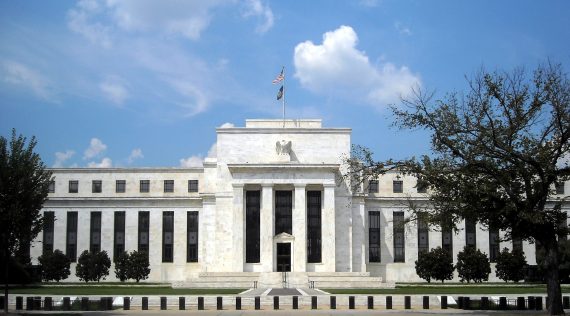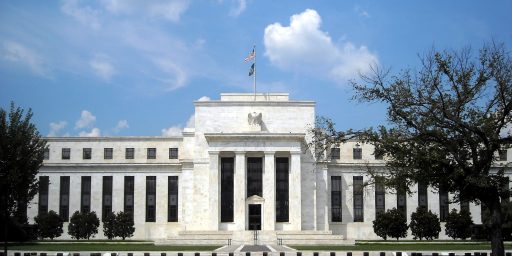Federal Reserve Raises Rates For Third Time Since December
For the third time since December,, the Federal Reserve has raised interest rates.
For the fourth time in 15 years, and the third time since December, the Federal Reserve Board has raised interest rates:
WASHINGTON — Demonstrating confidence in the health of the American economy, the Federal Reserve raised its benchmark interest rate for the third consecutive quarter on Wednesday.
The Fed also detailed its plans to reduce investment holdings, a step Fed officials expect to take this year.
The Fed, as expected, raised its benchmark rate to a range between 1 percent and 1.25 percent, citing the continued strength of job growth and dismissing, for now, the renewed weakness of inflation.
“The labor market has continued to strengthen,” the Fed said in an upbeat statement published after a two-day meeting of its policy-making committee. The Fed added that economic growth “has been rising moderately so far this year,” making no mention of the reported weakness last winter.
With rates on the rise, the Fed has said that it will soon begin to dismantle the last part of its post-crisis economic stimulus campaign by reducing its portfolio of more than $4 trillion in Treasuries and mortgage-backed securities. On Wednesday it described its plans, though not the exact timing.
The Fed said it would initially reduce its holdings by $10 billion a month for three months, divided 60-40 between Treasuries and mortgage bonds. It will then increase the pace by $10 billion every three months, maintaining the same division, until the reduction reaches $50 billion a month.
Shedding assets, like raising rates, is intended to increase borrowing costs for businesses and consumers. The Fed has concluded that the economy is growing about as fast as it can, so the central bank aims, by the end of the year, to return rates to a level that does not encourage additional borrowing.
So far, however, financial markets are not cooperating. Interest rates on auto loans have increased a little since the Fed started raising rates in 2015, but rates on mortgage loans remain unchanged. Rates on some corporate loans have declined. Measures of financial conditions have loosened.
It remains to be seen whether the latest rate increase will have a stronger influence on markets.
The Fed’s statement did acknowledge that inflation has weakened in recent months, which has forced the Fed to concede that it has once again been wrong about inflation. Fed officials now predict that prices will rise by just 1.6 percent this year, down sharply from their forecast of 1.9 percent in March. They continued to predict 2 percent inflation next year.
The Fed in recent years has been equally consistent in predicting 2 percent inflation, and in being wrong.
Neel Kashkari, president of the Federal Reserve Bank of Minneapolis, was the only member of the Federal Open Market Committee to vote against the rate increase. Mr. Kashkari has argued that economic conditions are not strong enough to justify raising the benchmark rate.
Most of the 16 Fed officials on the policy-making committee still expect to raise the Fed’s benchmark rate at least one more time this year, according to a compilation of their economic forecasts that the Fed released on Wednesday. Expectations for rate hikes weakened somewhat, but the median forecast still predicted the benchmark rate will stand at 3 percent at the end of 2019.
Based on some of the recent economic data that we’ve seen, such as the most recent jobs report and the report on the latest update on economic growth in the first quarter, this move seems like somewhat of a surprise. Based on those number, it most certainly doesn’t appear as if the economy is moving rapidly in a positive direction, or that the future looks as though it’s going to be anything other than the ho-hum economic growth that we’ve seen so far this year. In fact, several forecasts for the second quarter and beyond seem to indicate that the economy will barely grow at the pace we’re seeing for the first three months of the year. Average jobs growth is below where it has been in the past, for example, and the revisions that the Bureau of Labor Statistics makes to previous month reports always seem to be trending downward rather than upward. More importantly, there are few signs that inflation is returning or that there’s any prospect of it returning any time in the near future. Of course, the Federal Reserve has access to data that hasn’t been released to the public yet, as well as more detailed analysis, so it’s hard to say that they have made the wrong decision here, although both Kevin Drum and Matthew Yglesias do their best to do so in posts about the Board’s decision this afternoon.
In any case, it does appear that the Federal Reserve is committed to its previously announced plans to steadily raise rates that began with action back in December 2015. It’s also worth noting that, at this point, the Board has raised rates a grand total of just a tad over one percent since December 2015, and that it has done so at a rate that seems designed to have as little “shock” impact on the economy as possible. Additionally, the Board continues to forecast moderate but still positive economic growth going forward for the foreseeable future. Barring the possibility that economic forecasts and statistics start taking an unexpected dip or heating up unexpectedly, or that financial or other developments in the world take an unexpected turn, it’s likely that we’ll continue to see these quarterly increases in rates for the foreseeable future. That would put the next expected rate increase at September, with anything to follow in December. Those decisions, however, could also depend on action coming out of Washington as Congress and the Trump Administration try to accomplish everything from passing a FY 2018 Budget to passing a health care reform bill and getting tax reform and infrastructure funding is taken care of before the end of September. All of those programs could have an impact on the national debt, which in turn would have an impact on the cost of borrowing in the future and, in addition, could make further Congressional action more difficult if it means that we see a return of the deficit hawks.





Yup. There were signs of wages going up and the Fed is going to nip that in the bud.
?????
Doug, do you have a reference to support the contention that the size of the U.S. debt has a correlation to bond interest rates?
now that they don’t have to “correct the black man’s tip” !
but seriously, i was telling my kids how we used to be able to open a savings account and get 5-6% compound interest! they’ve never heard of such stuff…but there’s hope now.
Kids, it begins …
Special counsel is investigating Trump for possible obstruction of justice
I hope they didn’t order their stationery yet 😀
@Todd:
I think he means that the cost of servicing that debt will increase. If interest rates go up, the yield on treasuries will have to increase to remain as attractive.
@HarvardLaw92:
Add money laundering to that list.
Ain’t it grand? 😀
The start of a bad cycle. I am getting visions of the ’70’s.
See: “Secrets of the Federal Reserve” (it will amaze and astound). Also: “A History of Banking” (shocking).
@HarvardLaw92:
Honestly, their ‘stationery’ is Trump’s Twitter missives